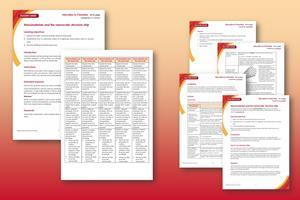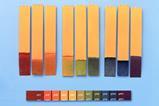Explore the nanoscale and develop your learners’ confidence in writing skills
This resource accompanies the article Small wonders in Education in Chemistry which provides context for the many and varied uses of nanomaterials.
Learning objectives
- Explore the topic of nanomaterials and the nanoscale.
- Understand how to calculate orders of magnitude and surface area to volume ratio.
- Practise drafting extended responses.
When your learners have finished using the structure strip they should have an A4 page set of notes and examples.
Introduction
Nanomaterials are becoming more and more important in everyday life and in scientific research. In this activity, your learners will develop their skills in reading and writing about nanomaterials and the nanoscale.
How to use structure strips
Structure strips are a type of scaffolding that support learners to write independently. You can use them in lots of ways: to take an overview at the start of the topic, to activate prior knowledge or to summarise a set of objectives.
Your learners should glue their structure strip into the margin of an exercise book or a piece of paper. The strips have sections containing prompts which are sized to show the amount learners must write. Learners write their answers next to the sections, in full sentences.
For more ideas on how to use structure strips with your learners, see 5 ways to use structure strips effectively.
Question
Get your learners to answer the question after they have completed the structure strip. The structure strip activates the required knowledge which learners can then apply to the following question.
“Gold nanoparticles can be used as catalysts. They cost £120 for a 25 cm3 bottle as a suspension. A lab orders bottles of 30 nm and 80 nm gold nanoparticles. Evaluate the use of these two sizes of nanoparticles including appropriate calculations.”
More structure strip resources
- Find out more about using structure strips to improve learners’ understanding through writing with this article, which includes a rates of reaction example.
- Find more structure strips on plant-based plastics, the politics of energy, and the movement of water through the water cycle.
- Assess core practical understanding using extended response questions supported by structure strips: conservation of mass, electrolysis, displacement reactions and more with our practical video collection.
- Follow up this electroplating copper coins with zinc ‘gold coins’ practical with a worksheet and extended response question, including a structure strip.
Scaffolding
For learners who need support, you can include a list of key words or additional prompts in the structure strip. As learners grow in confidence, they will be able to answer the question without the structure strip or attempt the question first and then use the structure strip to improve or self-assess their answer.
Answers
The answers to structure strip questions can be written as bullet points or prose. Indicative responses to the extended-response question can be found in the teacher notes.
- Explain the term ‘nanometre’.
- A nanometre is a very small unit of length, much smaller than a metre, cm or mm. It is 1 x 10-9 m which is 0.000000001 m.
- Define the term nanoscience and compare nanoparticles to coarse particles and fine particles.
- Nanoscience is the study of structures that are between 1 and 100 nanometres (nm) in size.
- Nanoparticles are typically made up of 1–100 atoms and have a size of 1–100 nm.
- Fine particles (sometimes called particulate matter) are bigger, they have a size of 100 to 2500 nm.
- Coarse particles are bigger again, 2500 to 10,000 nm.
- Give some uses of nanoparticles in everyday life and research.
- Nanoparticles are used as catalysts, in medical treatment, cosmetics and electronics. In everyday life they are used as sunscreens which block harmful UV light from the skin. Sunscreen contains zinc oxide. When it is used as fine particles it appears white on the skin but when zinc oxide nanoparticles are used the sunscreen isn’t visible on the skin.
- A gold atom has a diameter of 0.14 nm. Calculate what size gold nanoparticle is 10 times and 100 times larger than a gold atom.
- 0.14 nm gold atom.
- Ten times larger would be 0.14 x 10 = 1.4 nm.
- One hundred times larger would be 0.14 x 100 = 10.4 nm.
- These would still be considered to be on the nanoscale as they are between 1–100 nm diameter.
- Show, using an example, how to calculate the surface area (SA):volume (V) ratio of a cube shaped nanoparticle. Explain why SA:V ratio is an important property.
- A cube has six sides. For a cube with sides of 0.2 nm.
- Surface area of each side = 0.2 nm x 0.2 nm = 0.04 nm2.
- Six sides so 6 x 0.04 nm2 = 0.24 nm2.
- The volume of a cube can be calculated by cubing its sides (length x width x depth) which are all the same for a cube.
- For a side of 0.2 nm. Volume = 0.2 nm x 0.2 nm x 0.2 nm = 0.23 = 0.008 nm3.
- SA:V ratio = 0.24:0.008 = 0.24/0.008 = 30:1.
- Surface area to volume ratio is a property which can tell us how much reactive surface there is compared to the volume of the substance. A large surface area to volume ratio is preferred (eg for catalysts) as smaller amounts can be used. This is important as catalysts can be expensive.
- Describe the structure and bonding of a carbon nanotube. You may support your answer with a sketch.
- What are the properties of carbon nanotubes and how are they related to their structure and bonding?
- Carbon nanotubes are nanomaterials made from a single sheet of graphene rolled up to create a tube. Nanotubes are very long compared to their width. They have high length to diameter ratios. Each carbon atom in the graphene sheet is covalently bonded to 3 other carbon atoms. This leaves one of the 4 outer shell electrons free.
- Carbon nanotubes are strong (especially tensile strength where they resist being stretched). This is due to the strong covalent bonds between the carbon atoms. They are good conductors of electricity because the spare electron per carbon atom can be delocalised across the structure.
- Where do they sit on the nanoscale?
- Carbon nanotubes are nanomaterials. They have diameters between 0.4 and 40 nm and lengths from about 100 nm to a few millimetres.
- What are the properties of carbon nanotubes and how are they related to their structure and bonding?
More nanomaterial resources
- Read about the sunlight-activated nanofilm putting an end to misty glasses and windows in this Science research news story, and use the summary slide to add new context when teaching about nanomaterials with your 14–16 learners.
- Use the example of nanotechnology in socks to introduce ethics in science with this structured practice debate.
- Make your own sunscreen and determine its SPF in the ‘Nanoparticles in sunscreen challenge’, a Chemistry for All project.
- The Inspirational chemistry chapter ‘Nanotechnology’ suggests games, practicals and demonstrations for teaching various topics, including ways that nanotechnology can improve our everyday lives.
- Find out how Vicki, a nanotoxicologist, examines how nanomaterials in everyday products such as medicine, electronics and clothing interact with our bodies to ensure they are safe.
Downloads
Nanomaterials structure strip student sheet
Handout | PDF, Size 0.15 mbNanomaterials structure strip teacher notes
Handout | PDF, Size 0.17 mbNanomaterials structure strip student sheet
Editable handout | Word, Size 0.43 mbNanomaterials structure strip teacher notes
Editable handout | Word, Size 0.44 mb
























No comments yet